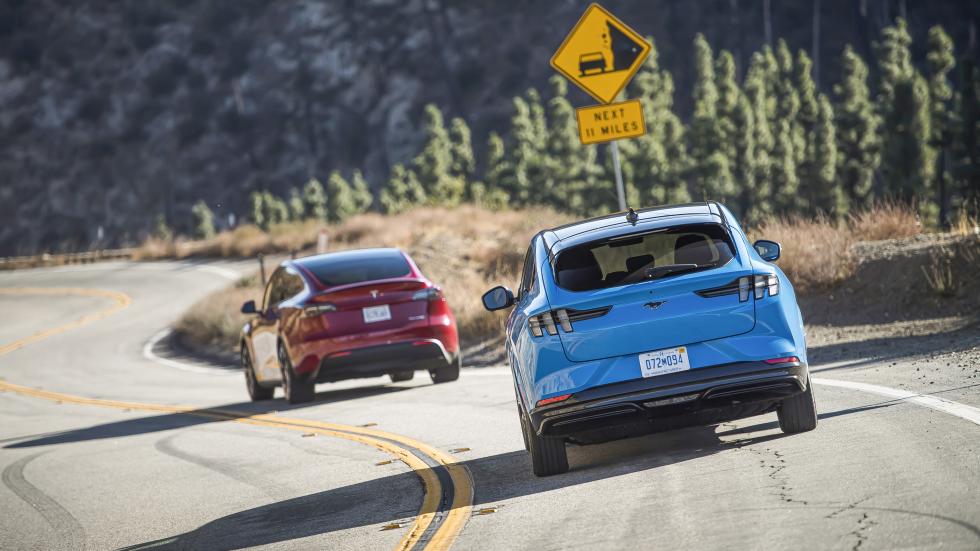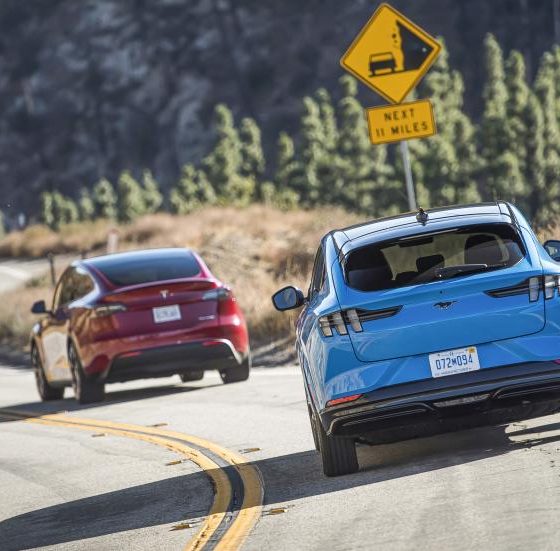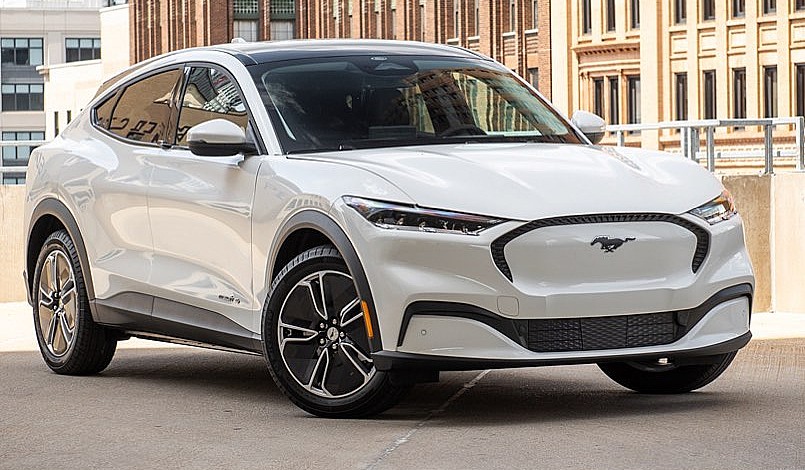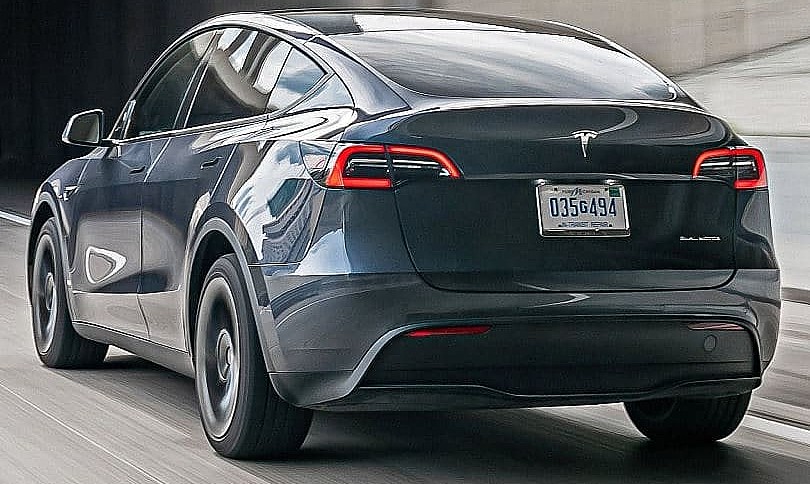

News
Tesla Model Y vs Ford Mustang Mach-E comparison gets the Top Gear treatment
The Tesla Model Y and the Ford Mustang Mach-E may be allies in the push for sustainable transportation, but the two vehicles, being both premium crossover SUVs, are bound to be compared. One of the most recent comparisons of the two cars was recently conducted by one of the motoring world’s most prominent outlets: Top Gear.
The veteran automotive publication used a Tesla Model Y Performance and a Ford Mustang Mach-E First Edition for its tests. Specs-wise, the Tesla was the clear winner despite its higher price. However, this is reasonably expected considering that the Model Y Performance is more comparable to the Mustang Mach-E GT, a vehicle that is yet to be released. The two all-electric crossovers were pitted against each other on four fronts—performance, interior and tech, exterior, and charging.

The results were quite interesting, if not a bit telling.
The Tesla Model Y is not a new car. It’s already been in production for about a year now, which meant that Ford had some time to refine the Mach-E before its release to ensure that it could outgun its Silicon Valley-based counterpart. Yet, according to Top Gear’s tests, this is not necessarily the case. The publication noted that the Model Y Performance proved to be a better driver’s car, lighter on its wheels, and quick to respond. The fact that it’s almost two seconds faster from 0-60 mph than the Mach-E was just icing on the cake.
This does not mean to say that the Mach-E was not an engaging car, of course. The publication praised the Ford crossover for its smooth and comfortable ride, which provided a plushier experience compared to the Model Y. However, the vehicle was found to feel quite heavy when being driven hard, which meant that the Mach-E is best enjoyed when it’s being kept within its modest boundaries.
The second and third rounds of the two vehicles’ comparison involved their interior and exterior, and in this sense, each vehicle came away with a win. While both vehicles’ interiors are tastefully designed—the Mach-E adopting a more forward take on a traditional interior and the Model Y adopting a “minimalist heaven” theme—the gap in their tech was notable. The Mustang Mach-E is equipped with robust tech features, but compared to the Model Y’s Autopilot and custom software, the Tesla proved superior.

Exterior-wise, however, the Mach-E proved the clear winner, as it drew far more interest among people than the Model Y. During its test, Top Gear noted that even hardened Mustang enthusiasts proved very enthusiastic about the Mach-E, with some noting that they would probably purchase the vehicle. On the other hand, the Model Y was largely invisible, likely mistaken by the layman as just another Model 3.
The final comparison of the two vehicles came in the form of a charging test, and in this sense, Tesla’s Supercharger Network ended up being a true difference-maker. The publication charged the vehicles when both had about 30% of their batteries left, and as luck would have it, both the Model Y and the Mach-E directed their drivers to a nearby shopping center. There, the Model Y found itself in a clean row of Superchargers that were ready to provide the all-electric crossover with enough charge in 45 minutes. Since it relied on third-party charging options, the Mach-E showed its driver that it needed 20 hours to charge up.
Ultimately, Top Gear noted that the Mustang Mach-E, at least at its current state, is not yet on the level of the Model Y, but it is a solid shot at a capable all-electric crossover. Hopefully, as more chargers are set up across the globe and as Ford becomes more experienced in making EVs, the automaker from Detroit could create a vehicle that could, pound-for-pound, match or even exceed its Tesla counterpart.
Don’t hesitate to contact us for news tips. Just send a message to tips@teslarati.com to give us a heads up.

Elon Musk
Elon Musk and Tesla AI Director share insights after empty driver seat Robotaxi rides
The executives’ unoccupied tests hint at the rapid progress of Tesla’s unsupervised Robotaxi efforts.

Tesla CEO Elon Musk and AI Director Ashok Elluswamy celebrated Christmas Eve by sharing personal experiences with Robotaxi vehicles that had no safety monitor or occupant in the driver’s seat. Musk described the system’s “perfect driving” around Austin, while Elluswamy posted video from the back seat, calling it “an amazing experience.”
The executives’ unoccupied tests hint at the rapid progress of Tesla’s unsupervised Robotaxi efforts.
Elon and Ashok’s firsthand Robotaxi insights
Prior to Musk and the Tesla AI Director’s posts, sightings of unmanned Teslas navigating public roads were widely shared on social media. One such vehicle was spotted in Austin, Texas, which Elon Musk acknowleged by stating that “Testing is underway with no occupants in the car.”
Based on his Christmas Eve post, Musk seemed to have tested an unmanned Tesla himself. “A Tesla with no safety monitor in the car and me sitting in the passenger seat took me all around Austin on Sunday with perfect driving,” Musk wrote in his post.
Elluswamy responded with a 2-minute video showing himself in the rear of an unmanned Tesla. The video featured the vehicle’s empty front seats, as well as its smooth handling through real-world traffic. He captioned his video with the words, “It’s an amazing experience!”
Towards Unsupervised operations
During an xAI Hackathon earlier this month, Elon Musk mentioned that Tesla owed be removing Safety Monitors from its Robotaxis in Austin in just three weeks. “Unsupervised is pretty much solved at this point. So there will be Tesla Robotaxis operating in Austin with no one in them. Not even anyone in the passenger seat in about three weeks,” he said. Musk echoed similar estimates at the 2025 Annual Shareholder Meeting and the Q3 2025 earnings call.
Considering the insights that were posted Musk and Elluswamy, it does appear that Tesla is working hard towards operating its Robotaxis with no safety monitors. This is quite impressive considering that the service was launched just earlier this year.
Elon Musk
Starlink passes 9 million active customers just weeks after hitting 8 million
The milestone highlights the accelerating growth of Starlink, which has now been adding over 20,000 new users per day.

SpaceX’s Starlink satellite internet service has continued its rapid global expansion, surpassing 9 million active customers just weeks after crossing the 8 million mark.
The milestone highlights the accelerating growth of Starlink, which has now been adding over 20,000 new users per day.
9 million customers
In a post on X, SpaceX stated that Starlink now serves over 9 million active users across 155 countries, territories, and markets. The company reached 8 million customers in early November, meaning it added roughly 1 million subscribers in under seven weeks, or about 21,275 new users on average per day.
“Starlink is connecting more than 9M active customers with high-speed internet across 155 countries, territories, and many other markets,” Starlink wrote in a post on its official X account. SpaceX President Gwynne Shotwell also celebrated the milestone on X. “A huge thank you to all of our customers and congrats to the Starlink team for such an incredible product,” she wrote.
That growth rate reflects both rising demand for broadband in underserved regions and Starlink’s expanding satellite constellation, which now includes more than 9,000 low-Earth-orbit satellites designed to deliver high-speed, low-latency internet worldwide.
Starlink’s momentum
Starlink’s momentum has been building up. SpaceX reported 4.6 million Starlink customers in December 2024, followed by 7 million by August 2025, and 8 million customers in November. Independent data also suggests Starlink usage is rising sharply, with Cloudflare reporting that global web traffic from Starlink users more than doubled in 2025, as noted in an Insider report.
Starlink’s momentum is increasingly tied to SpaceX’s broader financial outlook. Elon Musk has said the satellite network is “by far” the company’s largest revenue driver, and reports suggest SpaceX may be positioning itself for an initial public offering as soon as next year, with valuations estimated as high as $1.5 trillion. Musk has also suggested in the past that Starlink could have its own IPO in the future.
News
NVIDIA Director of Robotics: Tesla FSD v14 is the first AI to pass the “Physical Turing Test”
After testing FSD v14, Fan stated that his experience with FSD felt magical at first, but it soon started to feel like a routine.

NVIDIA Director of Robotics Jim Fan has praised Tesla’s Full Self-Driving (Supervised) v14 as the first AI to pass what he described as a “Physical Turing Test.”
After testing FSD v14, Fan stated that his experience with FSD felt magical at first, but it soon started to feel like a routine. And just like smartphones today, removing it now would “actively hurt.”
Jim Fan’s hands-on FSD v14 impressions
Fan, a leading researcher in embodied AI who is currently solving Physical AI at NVIDIA and spearheading the company’s Project GR00T initiative, noted that he actually was late to the Tesla game. He was, however, one of the first to try out FSD v14.
“I was very late to own a Tesla but among the earliest to try out FSD v14. It’s perhaps the first time I experience an AI that passes the Physical Turing Test: after a long day at work, you press a button, lay back, and couldn’t tell if a neural net or a human drove you home,” Fan wrote in a post on X.
Fan added: “Despite knowing exactly how robot learning works, I still find it magical watching the steering wheel turn by itself. First it feels surreal, next it becomes routine. Then, like the smartphone, taking it away actively hurts. This is how humanity gets rewired and glued to god-like technologies.”
The Physical Turing Test
The original Turing Test was conceived by Alan Turing in 1950, and it was aimed at determining if a machine could exhibit behavior that is equivalent to or indistinguishable from a human. By focusing on text-based conversations, the original Turing Test set a high bar for natural language processing and machine learning.
This test has been passed by today’s large language models. However, the capability to converse in a humanlike manner is a completely different challenge from performing real-world problem-solving or physical interactions. Thus, Fan introduced the Physical Turing Test, which challenges AI systems to demonstrate intelligence through physical actions.
Based on Fan’s comments, Tesla has demonstrated these intelligent physical actions with FSD v14. Elon Musk agreed with the NVIDIA executive, stating in a post on X that with FSD v14, “you can sense the sentience maturing.” Musk also praised Tesla AI, calling it the best “real-world AI” today.








